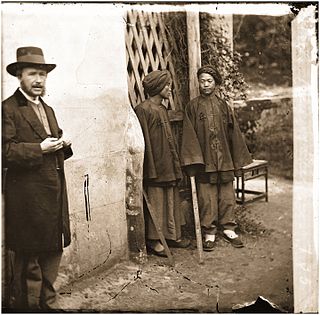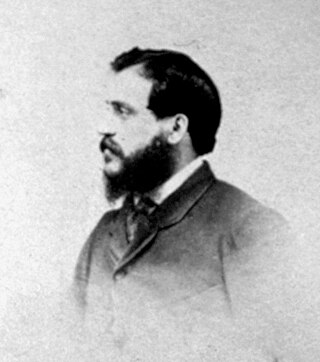Related Research Articles

Yousuf Karsh, FRPS was a Canadian photographer known for his portraits of notable individuals. He has been described as one of the greatest portrait photographers of the 20th century.

Midland is a town located on Georgian Bay in Simcoe County, Ontario, Canada. It is part of the Huronia/Wendat region of Central Ontario.

The American Civil War was the most widely covered conflict of the 19th century. The images would provide posterity with a comprehensive visual record of the war and its leading figures, and make a powerful impression on the populace. Something not generally known by the public is the fact that roughly 70% of the war's documentary photography was captured by the twin lenses of a stereo camera. The American Civil War was the first war in history whose intimate reality would be brought home to the public, not only in newspaper depictions, album cards and cartes-de-visite, but in a popular new 3D format called a "stereograph," "stereocard" or "stereoview." Millions of these cards were produced and purchased by a public eager to experience the nature of warfare in a whole new way.

George Washington Wilson was a pioneering Scottish photographer. In 1849, he began a career as a portrait miniaturist, switching to portrait photography in 1852. He received a contract to photograph the Royal Family, working for Queen Victoria and Prince Albert. He pioneered various techniques for outdoor photography and the mass production of photographic prints as he gradually began to largely do landscape photography in the 1860s. By 1864 he claimed to have sold over half a million copies.

William Notman was a Scottish-Canadian photographer and businessman. The Notman House in Montreal was his home from 1876 until his death in 1891, and it has since been named after him. Notman was the first photographer in Canada to achieve international recognition.

Samuel Bourne was a British photographer known for his prolific seven years' work in India, from 1863 to 1870. Together with Charles Shepherd, he set up Bourne & Shepherd first in Shimla in 1863 and later in Kolkata (Calcutta); the company closed in June 2016.

Charles Roscoe Savage was a British-born landscape and portrait photographer most notable for his images of the American West. Savage converted to the Church of Jesus Christ of Latter-day Saints in his youth while living in England. He served a mission in Switzerland and eventually moved to the United States. In America he became interested in photography and began taking portraits for hire in the East. He traveled to Salt Lake City with his family and opened up his Art Bazar where he sold many of his photographs. Savage concentrated his photographic efforts primarily on family portraits, landscapes, and documentary views. He is best known for his 1869 photographs of the linking of the First transcontinental railroad at Promontory, Utah.

War photography involves photographing armed conflict and its effects on people and places. Photographers who participate in this genre may find themselves placed in harm's way, and are sometimes killed trying to get their pictures out of the war arena.

Maxwell Spencer Dupain AC OBE was an Australian modernist photographer.

Adolfo Farsari was an Italian photographer based in Yokohama, Japan. His studio, the last notable foreign-owned studio in Japan, was one of the country's largest and most prolific commercial photographic firms. Largely due to Farsari's exacting technical standards and his entrepreneurial abilities, it had a significant influence on the development of photography in Japan.

John Thomson FRGS was a pioneering Scottish photographer, geographer, and traveller. He was one of the first photographers to travel to the Far East, documenting the people, landscapes and artefacts of eastern cultures. Upon returning home, his work among the street people of London cemented his reputation, and is regarded as a classic instance of social documentary which laid the foundations for photojournalism. He went on to become a portrait photographer of High Society in Mayfair, gaining the Royal Warrant in 1881.

Felice Beato, also known as Felix Beato, was an Italian–British photographer. He was one of the first people to take photographs in East Asia and one of the first war photographers. He is noted for his genre works, portraits, and views and panoramas of the architecture and landscapes of Asia and the Mediterranean region. Beato's travels gave him the opportunity to create images of countries, people, and events that were unfamiliar and remote to most people in Europe and North America. His work provides images of such events as the Indian Rebellion of 1857 and the Second Opium War, and represents the first substantial body of photojournalism. He influenced other photographers, and his influence in Japan, where he taught and worked with numerous other photographers and artists, was particularly deep and lasting.

Gertrude Käsebier was an American photographer. She was known for her images of motherhood, her portraits of Native Americans, and her promotion of photography as a career for women.
Andrew Miscampbell was an Ontario political figure. He represented Simcoe East from 1890 to 1902 and Sault Ste. Marie from 1902 to 1903 as a Conservative member of the Legislative Assembly of Ontario.
The Huronia Museum is located in Midland, Ontario, Canada. The museum consists of the museum building and the Huron/Ouendat (Wendat) village. The museum is open year-round and has nearly one million objects and receives some 20,000 visitors each year. The collections include artifacts pertaining to native history and maritime history. The museum provides educational programmes for schools and adults.
Mike Grandmaison is a Canadian freelance photographer specializing in nature - landscapes, plants and wildlife. Grandmaison is well known for his images created of Canada. His commercial assignment photography focuses on architecture, agriculture, nature, the environment, travel and Canadian tourism. Photographs from his extensive and eclectic stock photography collection are licensed through his own website as well as through stock agencies in North America. Grandmaison markets his fine art photographs principally online through 'The Canadian Gallery' of his website.

Lai Afong was a Chinese photographer who established Afong Studio, considered to be the most successful photographic studio in the late Qing Dynasty. He is widely acknowledged as the most significant Chinese photographer of the nineteenth century.
The practice and appreciation of photographyin the United States began in the 19th century, when various advances in the development of photography took place and after daguerreotype photography was introduced in France in 1839. The earliest commercialization of photography was made in the country when Alexander Walcott and John Johnson opened the first commercial portrait gallery in 1840. In 1866, the first color photograph was taken. Only in the 1880s, would photography expand to a mass audience with the first easy-to-use, lightweight Kodak camera, issued by George Eastman and his company.
John Vanderpant was a Dutch-Canadian photographer, gallery owner and author. He made his living doing portrait work while becoming known as a major member of the International Modernist photography movement in Canada. He was a key figure in Vancouver's artistic community.

Photographs have been taken in the area now known as Canada since 1839, by both amateurs and professionals. In the 19th century, commercial photography focussed on portraiture. But professional photographers were also involved in political and anthropological projects: they were brought along on expeditions to Western Canada and were engaged to document Indigenous peoples in Canada by government agencies.
References
- Hunter, James. Visions of Huronia's Past: An Exhibition of the Works of Midland Photographer, J.W. Bald. Huronia Museum, 1988.